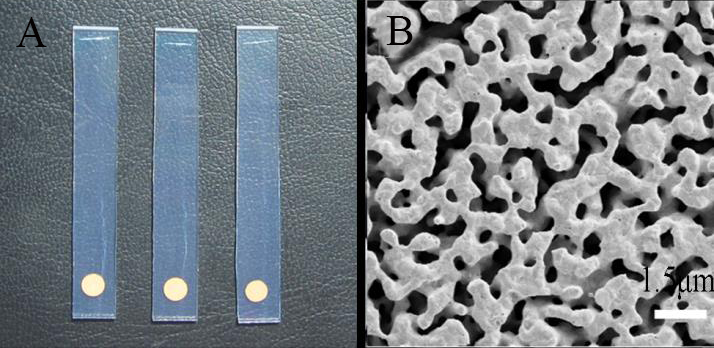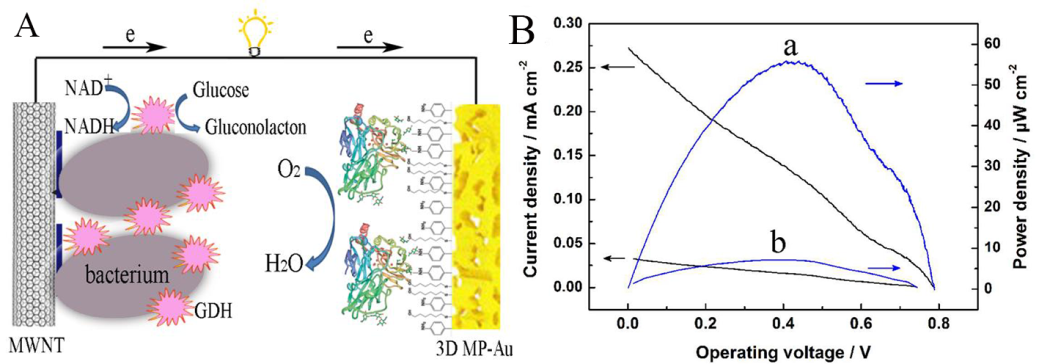QIBEBT Developed High-Power-Output Biofuel Cells
Biofuel cell (BFC) is a particular fuel cell configuration, which can convert biomass to electrical energy by enzymatic biocatalysts and electricigens in an electrochemical way. Due to its mild working condition, low-cost biofuel and good biocompatibility, BFC has a good application prospect. The researchers from Qingdao Institute of Bioenergy & Bioprocess Technology (QIBEBT) have made a series of progress in BFC based on nanotechnology and bacteria surface displayed enzyme. They have developed novel BFCs with high power output and good stability, which may have broad applications in implantable power in vivo and portable power.
The Laboratory for Biosensing in QIBEBT adopted a protein templating approach to prepare a three-dimensional (3D) porous gold film on fluorine-doped tin oxide (FTO). FTO was further used for covalent immobilization of laccase to obtain the biocathode. This significantly improved the efficiency of laccase immobilization and realizing the direct electron transfer. Further, the proposed biocathode can catalyze the oxygen reduction at a high onset potential of 0.62 V (vs. SCE).
On the other hand, mutated glucose dehydrogenase surface displayed bacteria (GDH-bacteria) were used to improve the stability of the glucose oxidation at the bioanode. The as-assembled membraneless glucose/O2 fuel cell showed a high power output of 55.8 μW cm?2 and open circuit potential of 0.80 V. Moreover, the BFC retained 84% of its maximal power density even after continuous operation for 55 h. This work found a solution to the issues of poor stability and high cost of enzymes met for enzyme-based BFC. The results have been published in Analytical Chemistry (C. Hou, et al., Analytical Chemistry 2014, 86, 6057–6063.).
Additionally, the researchers also developed a membraneless BFC with a xylose dehydrogenase surface displayed bacteria based bioanode. This BFC achieved an open circuit potential of 0.58 V and a high power output of 63 μW cm?2, which was 60% higher than that of purified xylose dehydrogenase based BFC with the same enzyme activity. (L. Xia, et al., Biosensors & Bioelectronics 2013, 44, 160). This laboratory also constructed a sequential enzyme based BFC with starch as the biofuel (Q. Lang, et al., Biosensors & Bioelectronics, 2014, 51, 158-163).
This research was led by Prof. LIU Aihua from the Laboratory for Biosensing, QIBEBT. This work was supported by the National Natural Science Foundation of China.
Figure 1. Photograph (A) and SEM image (B) of3Dporous gold film on FTO. Figure 2. (A) Schematic representation of the developed BFC composed of a laccase-based 3D porous gold film biocathode and bacterial surface displaying GDH mutant-based bioanode; (B) Dependence of the power density on the cell voltage: curve a, laccase-based 3D porous gold film biocathode; curve b,laccase-immoblized planar gold biocathode. (Image by the Laboratory for Biosensing, QIBEBT)

(Image by the Laboratory for Biosensing, QIBEBT)

Reference:
1. Analytical Chemistry2014,86, 6057–6063.
2. Biosensors & Bioelectronics2013,44, 160–163.
3. Biosensors and Bioelectronics2014,51, 158–163.
Contact:
Prof. LIU Aihua
Email: liuah (AT) qibebt.ac.cn
Web: http://english.qibebt.cas.cn